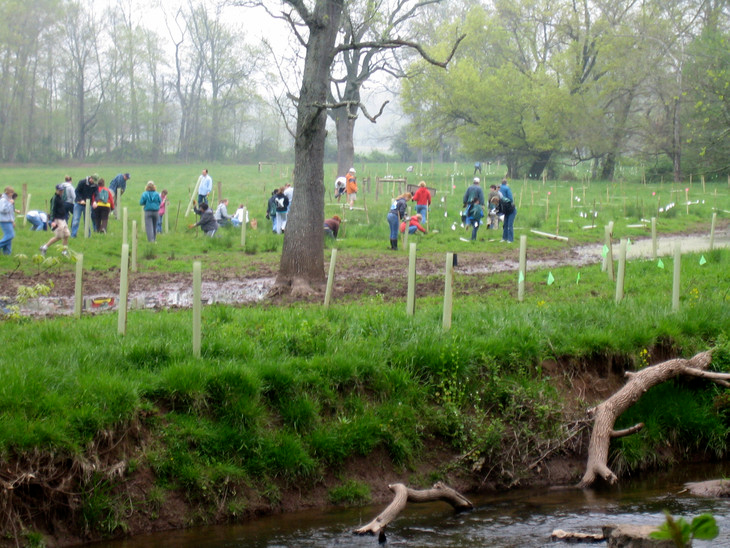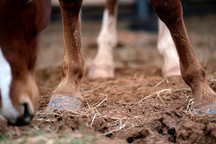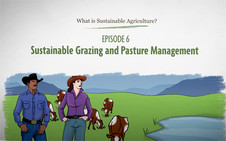| Having trouble viewing this email? View it as a Web page.  | | | Editor: Kelly Sprute June 16, 2021 Making a Difference  Volunteers planting riparian buffer areas along Conewago Creek. Photo courtesy of Penn State University. Study Looks at Nitrogen Credit Trading to Spur Growth of Riparian Buffers Watershed-wide nutrient credit trading has been suggested as a mechanism for reducing agricultural pollution entering the Chesapeake Bay, but a new study by Penn State University researchers suggests that the high cost of producing nitrogen credits through the establishment of riparian buffers on Pennsylvania farmland currently does not incentivize buffer establishment. In a nutrient trading market, sources that reduce their nutrient runoff or discharges below target levels can sell their surplus reductions or "credits" to other sources. This approach allows those who can reduce nutrients at low cost to sell credits to those facing higher-cost nutrient reduction options. However, increases in the market price of nitrogen credits or bundling nitrogen with other nutrient credits, such as phosphorus, ultimately could result in credit trading, providing an adequate incentive for agricultural riparian buffer establishment. The Northeast Woody/Warm-season Biomass Consortium and USDA's National Institute of Food and Agriculture supported this work. For more information, read the Penn State News article. | |  Tomorrow is NIFA's Virtual Stakeholder Listening Session The USDA's National Institute of Food and Agriculture (NIFA) will conduct a virtual listening session tomorrow from 11 a.m. to 12:30 p.m. (Central). The purpose of the virtual listening session is to seek stakeholder input on future priorities for NIFA research, education, and extension programs. For more information, or to register, go to NIFA's online announcement. |  Illustration of dairy farmer courtesy of Adobe Stock. Please take this short survey to help us improve NIFA's website. The purpose of this survey is to gain insight into how to enhance NIFA's online presence and serve our nation. Survey insights direct our evaluation and prioritization of opportunities, from general enhancements to specific requests, to improve the user experience. We do not collect personally identifiable information (PII) without your explicit consent. Any PII you choose to provide to USDA will be used only for the stated purpose. We will protect your information consistent with the principles of the Privacy Act of 1974, the E-Government Act of 2002, and the Federal Records Act.  NIFA Awards Over $19M in Scholarships for Undergraduates at 1890 Land-Grant Institutions NIFA recently announced an investment of over $19 million in 1890 Land-grant Institutions scholarships for undergraduate students to stimulate interest in food and agricultural careers. "As we work to increase the talent pipeline for the agricultural innovation workforce and the next generation of agricultural scientists, we need the brightest minds from across all areas and cultures in our society to be represented," said NIFA Director Dr. Carrie Castille. "NIFA's 1890 Scholarships Program helps us move closer to that goal by providing scholarships to support recruitment, engagement, retention, mentoring, and training of undergraduate students at 1890 Land-grant Institutions, the Historically Black Colleges and Universities that are partners in the U.S. Land-grant University System." For more information, read the NIFA press release. Student with books and tablet, courtesy of Getty Images. |  New Grant Program to Help Expand Regional Economies and Create High-Wage Jobs in Distressed Rural Communities USDA's Rural Development Rural Business-Cooperative Service Administrator Karama Neal recently unveiled a new grant program to help rural communities create good-paying jobs and support new business opportunities in high-growth fields. Rural Innovation Stronger Economy is intended to help rural communities identify and maximize local assets and connect to networks and industry clusters within their region. The new grant encourages a regional, innovation-driven approach to economic development. For more information, read the USDA press release. |  A Celebration of MyPlate USDA's symbol of nutrition guidance celebrates its 10th anniversary this year. USDA's Rod Bain talks with Agriculture Secretary Tom Vilsack about the past, present, and perhaps a glimpse of the future, of MyPlate. For more information, listen to this USDA broadcast. |  Consumers Will Pay More for Ready-to-Eat Meals Made with Fewer Ingredients Consumers today, more than ever, are seeking out fewer, simpler, more natural ingredients. A recent study by researchers at Washington State University (WSU), supported by USDA-National Institute of Food and Agriculture's Agriculture and Food Research Initiative competitive grants program, concluded that consumers even want clean labels from convenient, ready-to-eat meals. Consumers were willing to pay more for ready‑to‑eat meals with a "clean label" showing few ingredients, the study noted, as well as for processed foods, made with a new technology that helps limit the number of additives and preservatives commonly found in most ready‑to‑eat meals. For more information, read the WSU insider article. Healthy ready-to-eat meals, courtesy of Getty Images. |  NIFA Career Opportunities We are hiring! Remember to check out NIFA's Career Opportunities webpage, where there is a direct link to all open positions. You can also explore NIFA jobs at the USAjobs.gov website. Current openings in Kansas City, Missouri: Visual Information Specialist (GS 9-11)
Closing Date: 06/18/2021 Staff Accountant (GS 9-12)
Closing Date: 06/28/2021 Staff Accountant (GS 9-12)
Closing Date: 06/28/2021 Financial Policy Specialist (GS 9-12)
Closing Date: 06/28/2021 Financial Policy Specialist (GS 9-12)
Closing Date: 06/28/2021 Lead Financial Specialist (GS-13)
Closing Date: 06/28/2021 Biological Science Specialist (National Program Leader) (GS 13-14)
Closing Date: 07/09/2021 |  Researchers Study Effects of Bisphosphonates in Young Horses A common practice within the horse industry meant to strengthen the bones of mature horses could lead to bone breakdown in juvenile horses. Texas A&M University, Montana State University, and Michigan State University researchers are examining the effects of bisphosphonates in young horses. Bisphosphonate use in juvenile, exercising horses could result in greater risk of death for horses and humans, and to the eventual elimination of racing and the jobs surrounding the industry, according to Texas A&M Assistant Professor of equine science Jessica Leatherwood. The study, Bisphosphonate Pharmacokinetics and Comprehensive Effects on Juvenile Cartilage, Bone Growth and Healing: Implications for Animal Welfare, has been provided funding from USDA's National Institute of Food and Agriculture. For more information, read the Texas A&M Agrilife Today article. Image of horse grazing, courtesy of Texas A&M AgriLife by Laura McKenzie. |  Extension Services Partnership to Enhance Vaccine Education West Virginia University (WVU) Extension Service and West Virginia State University Extension Service have received nearly $250,000 to enhance vaccine education and immunization outreach to West Virginians. The award was presented by the Extension Foundation, in cooperation with the Extension Committee on Organization and Policy, through an Interagency Agreement with USDA's National Institute of Food and Agriculture and the Centers for Disease Control and Prevention to address health disparities among rural and other underserved communities across the U.S. The Extension Collaborative on Immunization Teaching and Engagement initiative is a result of the recent announcement from the CDC to provide $9.95 million funding to NIFA to support an innovative approach to community education and partnerships to advance adult immunization. For more information, read the WVU Extension article. Students receiving vaccine, photo courtesy of West Virginia University. |  How to Improve Soil Health and Plant Vigor A new "Sustainable Grazing and Pasture Management" video shows how farmers can improve soil health and plant vigor by focusing on the health of their pastures and rangelands. This simple animation is a great introduction to the basic principles of sustainable livestock management and is intended to complement more detailed training materials. For more information. For more information, watch the Sustainable Agriculture Research and Education video. |  | | | NIFA's mission is to invest in and advance agricultural research, education, and extension that solve societal challenges. NIFA's investments in transformative science directly support the long-term prosperity and global preeminence of U.S. agriculture. Keep informed about NIFA, USDA, our land-grant and non-land-grant university partners, and stakeholders with the NIFA Update. Read past issues online, sign up for email updates or follow us on Twitter @USDA_NIFA, #NIFAImpacts or LinkedIn @usda-nifa. If you wish to submit a news item or information, send an email to NIFAUpdate. USDA is an equal opportunity lender, provider, and employer. | | | |

No comments:
Post a Comment